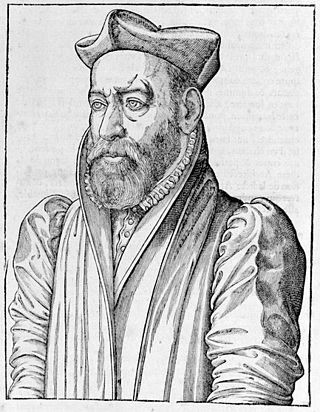Contents
| |||||
| Decades: | |||||
|---|---|---|---|---|---|
| See also: | Other events of 1539 History of France • Timeline • Years | ||||
Events from the year 1539 in France
| |||||
| Decades: | |||||
|---|---|---|---|---|---|
| See also: | Other events of 1539 History of France • Timeline • Years | ||||
Events from the year 1539 in France


Saint-Germain-en-Laye is a commune in the Yvelines department in the Île-de-France in north-central France. It is located in the western suburbs of Paris, 19.1 km (11.9 mi) from the centre of Paris.

Yvelines is a department in the western part of the Île-de-France region in Northern France. In 2019, it had a population of 1,448,207. Its prefecture is Versailles, home to the Palace of Versailles, the principal residence of the King of France from 1682 until 1789, a UNESCO World Heritage Site since 1979. Yvelines' subprefectures are Saint-Germain-en-Laye, Mantes-la-Jolie and Rambouillet.

Amboise is a commune in the Indre-et-Loire department in central France. Today a small market town, it was once home of the French royal court.

Philibert de l'Orme was a French architect and writer, and one of the great masters of French Renaissance architecture. His surname is also written De l'Orme, de L'Orme, or Delorme.

Villers-Cotterêts is a commune in the Aisne department in Hauts-de-France, France. It is notable as the signing-place in 1539 of the Ordinance of Villers-Cotterêts discontinuing the use of Latin in official French documents, and as the birthplace in 1802 of French novelist Alexandre Dumas père.

The arrondissement of Saint-Germain-en-Laye is an arrondissement of France in the Yvelines department in the Île-de-France region. It has 44 communes. Its population is 527,408 (2021), and its area is 350.9 km2 (135.5 sq mi).

The arrondissement of Châlons-en-Champagne is an arrondissement of France in the Marne department in the Grand Est region. It has 149 communes. Its population is 107,923 (2021), and its area is 2,612.4 km2 (1,008.7 sq mi).

The arrondissement of Château-Thierry is an arrondissement of France in the Aisne department in the Hauts-de-France region. It has 108 communes. Its population is 69,781 (2021), and its area is 1,115.2 km2 (430.6 sq mi).

The arrondissement of Soissons is an arrondissement of France in the Aisne department in the Hauts-de-France region. It has 163 communes. Its population is 107,344 (2021), and its area is 1,342.3 km2 (518.3 sq mi).

Le Pecq is a commune in the Yvelines department in the Île-de-France region in north-central France. It is located in the western suburbs of Paris, 18.4 km (11.4 mi) from the center of Paris.

Saint-Germain-en-Laye is the main railway station serving Saint-Germain-en-Laye, France. The station opened on 14 August 1847 with the opening of the Paris-St-Lazare–St-Germain-en-Laye railway, ligne de Saint Germain, an atmospheric railway. Twelve years later, conventional locomotives replaced the atmospheric powered engines. The original station had a large veranda building above the terminating lines.

The Lycée International de Saint-Germain-en-Laye is a French public school located in Saint-Germain-en-Laye, Yvelines, in the western suburbs of Paris, France. Established in 1952 as a school for the children of international personnel working at Supreme Headquarters Allied Powers Europe (SHAPE) in nearby Rocquencourt, the Lycée International caters to students with international and multilingual backgrounds.

The Château de Saint-Germain-en-Laye is a former royal palace in the commune of Saint-Germain-en-Laye, in the department of Yvelines, about 19 km west of Paris, France. Today, it houses the Musée d'Archéologie nationale.

Chambourcy is a commune in the Yvelines department in the Île-de-France region in north-central France. It is located 3 km (1.9 mi) west of Saint-Germain-en-Laye and about 25 km (16 mi) west of Paris.

Le Mesnil-le-Roi is a commune in the Yvelines department in the Île-de-France region in north-central France. It is about 3.5 km (2 mi) from Saint-Germain-en-Laye.

Philippe-Charles, Duke of Anjou was the fifth child and second son of King Louis XIV of France and Maria Theresa of Spain, and as such was a fils de France.

Gardens of the French Renaissance were initially inspired by the Italian Renaissance garden, which evolved later into the grander and more formal jardin à la française during the reign of Louis XIV, by the middle of the 17th century.

The Château-Neuf de Saint-Germain-en-Laye was a French château in Saint-Germain-en-Laye, now mostly demolished, which served as a royal residence from the second half of the 16th century until 1680. It was built on the grounds of the older Château de Saint-Germain-en-Laye, which became known as the Château-Vieux.

Eugène Louis Millet was a French architect. He planned and began the restoration of the Château de Saint-Germain-en-Laye, home of the Museum of National Antiquities.

Antoine Paul Selmersheim was a French diocesan architect. He is known for his design, construction, and restoration efforts on many churches during the 19th century. He became inspector-general of historical monuments.